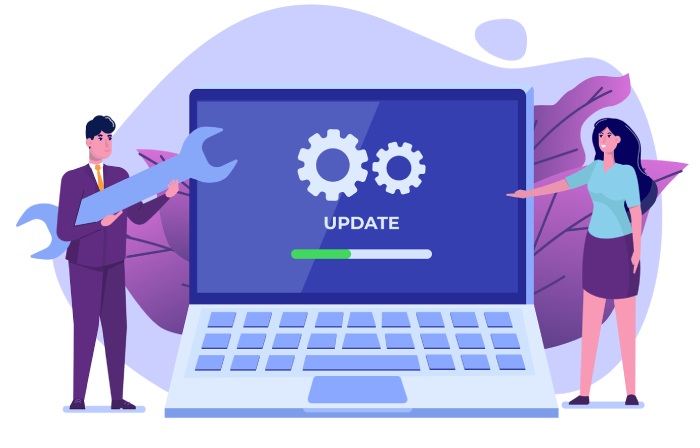In today’s tech-driven world, the threat of zero-day attacks looms larger than ever. These types of cyber threats catch many organizations off guard, often exploiting vulnerabilities before anyone knows they exist. Imagine a thief sneaking into your home through a door you didn’t even know was unlocked—that’s the reality for many businesses facing these hidden dangers.
Protecting your systems requires more than just traditional security measures; it calls for a proactive and multi-faceted approach to cybersecurity. In this article, we’ll explore effective strategies for defending against zero-day attacks, ensuring your organization stays two steps ahead of potential threats.
The best practices for zero-day attack prevention include implementing a multi-layered security approach, which involves regularly updating systems and software, conducting vulnerability scanning to identify potential risks, and employing next-generation firewalls for deeper inspection of incoming traffic. Additionally, staying informed about emerging threats and collaborating closely with security vendors will enhance your organization’s defenses against these unpredictable attacks.
Proactive Approaches to Prevention
One of the most effective ways to secure your organization against unforeseen threats is through threat intelligence. This involves utilizing specialized services which gather and analyze data about potential threats prior to their emergence. If you think about it, this is like having a weather radar for storms before they hit. Companies such as Recorded Future and FireEye offer resources that provide real-time updates on newly discovered vulnerabilities, allowing organizations to act with foresight rather than reaction.
With threat intelligence in your arsenal, you’re not just passively waiting for problems; you’re actively seeking out information that helps you prepare and counteract emerging risks.
However, knowledge alone isn’t enough to bolster defenses; you must also simulate real-world conditions.
Red Team Exercises
Regular red team exercises serve as an invaluable tool in the battle against cyber threats. These exercises involve a group of security experts—often referred to as the red team—who simulate real-world attack scenarios targeting your company’s assets. Think of it like a fire drill, where you test protocols and responses without the actual flames. The aim here is simple: identify weaknesses in your systems before unethical actors have a chance to exploit them. Some organizations take this approach further by implementing a purple team in cybersecurity, where red and blue teams collaborate directly rather than working in isolation, leading to more efficient vulnerability identification and faster remediation processes.
To gain the most value from these exercises, it’s crucial that your blue team—the defenders—remain unaware of when these simulations will occur. This approach ensures that their reactions during an attack scenario are genuine and reflective of what would happen in a true security breach. By practicing under these realistic conditions, your team can learn how to respond effectively and swiftly to actual threats.
By employing both threat intelligence and red team exercises together, you’ll develop a well-rounded security posture that stays ahead of potential vulnerabilities.
Vigilance through preparation can mean the difference between being caught off guard by a zero-day exploit and having robust defenses ready to counteract its effects. The essence of proactive security lies not only in understanding threats but actively preparing for them—like always keeping an umbrella handy for those surprise rain showers.
As we transition from proactive measures, it’s essential to focus on maintaining your systems through consistent upkeep and timely upgrades.
Regular Patching and Updates
Software vulnerabilities create pathways for potential threats to infiltrate systems. As software companies regularly discover these vulnerabilities, they also release patches to mitigate risks. Yet, the real challenge lies in ensuring these patches are applied promptly. Just receiving an update is not enough; timely implementation is crucial, especially when considering that 60% of data breaches involve vulnerabilities that could have been prevented with proper patch management, according to Verizon. That’s a staggering statistic—one that underscores the need for organizations to be proactive about patching.
To put this into perspective, studies have shown that organizations implementing consistent patch management can reduce their risk of cyberattacks by up to 40%. Companies like IBM report that the cost of a data breach due to unpatched vulnerabilities averages more than $4 million. Clearly, staying ahead with patches isn’t just good for security; it makes sound business sense.
One approach organizations can use is to implement automated patch management systems like Ivanti or ManageEngine. These solutions help ensure that patches are applied without delays, essentially taking the manual labor out of the process—which can often be a bottleneck. Automating your patch management means reducing human error and making sure your defenses are always up-to-date.
However, while speed is important, it’s equally critical to consider quality assurance. A rushed implementation can lead to unstable systems or unintended consequences if a patch disrupts functionality.
The Importance of Timely Patching
With urgency in mind, the next logical step is testing before deploying updates across the board. All too often, organizations might feel pressured to implement patches immediately, but neglecting testing can lead to significant issues. Imagine you’re a ship captain navigating through rocky waters; if you don’t first check your map (which is akin to testing updates), you may end up grounding your vessel on hidden rocks.
Testing updates in a controlled environment allows IT teams to confirm that updates don’t disrupt system functionality. This should include running simulations or using a small group of systems before wider deployment. By taking this precautionary measure, you ensure that any potential conflicts or errors are addressed upfront, preventing headaches down the line and allowing for smooth transitions across your technology landscape.
Through effective patch management strategies and rigorous testing practices, organizations can fortify their defenses against emerging threats. Transitioning into more sophisticated security mechanisms will further enhance resilience in this constantly evolving landscape.
Advanced Detection Tools
The challenge with zero-day threats is that they exploit unseen vulnerabilities before any patch or signature update can occur. Relying on outdated antivirus solutions can leave you exposed because they primarily depend on known malware signatures to identify threats. This means inbound attacks could easily bypass these defenses undetected until it’s too late. To mitigate this risk, integrating advanced threat detection tools into your security strategy is essential.
Endpoint Detection and Response (EDR)
One powerful tool in this arsenal is Endpoint Detection and Response (EDR). EDR solutions like CrowdStrike and Carbon Black provide heightened visibility into endpoint activities by continuously monitoring for suspicious behavior. Unlike traditional software, which relies on pattern recognition of existing malware, EDR solutions leverage advanced analytics and behavioral analysis.
By focusing on the actual behavior of programs and users, EDR can pinpoint anomalies that signal potential zero-day exploits. For instance, if an application suddenly starts accessing files it normally wouldn’t, or if user accounts begin performing actions that go against established protocols—these irregularities can trigger alerts for further investigation. This proactive identification helps provide an extra layer of defense until vulnerabilities can be patched.
As we move deeper into technological advancements, another frontier has emerged: the incorporation of Artificial Intelligence (AI) and Machine Learning (ML) into cybersecurity frameworks.
Artificial Intelligence and Machine Learning
Utilizing AI and machine learning fundamentally changes how we monitor and respond to cyber threats. These technologies analyze vast amounts of data rapidly, uncovering potential threats significantly quicker than human analysts could ever hope to achieve. An interesting example is Darktrace, a company that employs sophisticated AI algorithms to learn the normal behavior of an organization’s network.
When their system detects subtle deviations from this established norm— which are often characteristic of zero-day attacks—it provides early warnings. This early detection enables organizations to enact a rapid response plan to curtail potential damage. Automation powered by AI allows for not just reactionary measures but also creates adaptive defenses that learn and evolve in tandem with incoming threats.
In a world increasingly dependent on interconnected systems, employing a multifaceted approach through advanced detection tools can greatly enhance security. Companies need to recognize that protecting their assets requires more than just reactive measures; it necessitates a blend of innovative technology designed to detect emerging threats swiftly and efficiently.
Understanding these advanced detection methods sets the stage for exploring how continuous supervision and protective measures strengthen your overall cybersecurity posture.
Network Monitoring and Defenses
Effective network monitoring is like having a watchful guardian, always on the lookout for any signs of unauthorized activity that could signal a looming zero-day exploit. By continuously analyzing traffic, organizations can pinpoint anomalies that might otherwise pass unnoticed. It’s this proactive engagement with network behavior that empowers IT teams to act before issues escalate into significant threats, ensuring a robust defense system in place.
Intrusion Detection and Prevention Systems (IDPS)
One essential component of network monitoring is the deployment of Intrusion Detection and Prevention Systems (IDPS), such as Snort or Suricata. These systems monitor network traffic in real-time and detect malicious activities, blocking them before they cause harm. The critical distinction between detection and prevention cannot be overstated; while detection alerts the team of potential threats, prevention stops unauthorized access in its tracks. This aspect makes IDPS vital in an age where zero-day vulnerabilities pose serious risks.
Here is a comparison of two popular IDPS solutions:
| Feature | Snort | Suricata |
| Open Source | Yes | Yes |
| Protocols | Multiple | Multiple |
| Scalability | Moderate | High |
| Performance | Good | Excellent |
With robust tools such as IDPS integrated into your network’s defenses, it’s equally important not to overlook the protection offered at the endpoint level.
Endpoint defenses serve as the last line of protection for devices connected to your network. An effective strategy incorporates anti-malware and endpoint detection solutions that work in tandem with network protocols to create a multilayered approach. Cybersecurity threats often exploit unprotected endpoints—think of mobile devices or laptops brought into corporate networks. Strong endpoint protection strategies can deter attacks before they breach your larger systems.
Incorporating AI-driven solutions into endpoint defenses helps identify not just known signatures but also unusual patterns indicative of developing threats. Understanding these behaviors allows your systems to adapt, searching for anomalies that may represent zero-day attacks.
Integrating real-time network monitoring with strong IDPS and endpoint security establishes a comprehensive defense framework that can significantly lower vulnerability risks related to zero-day exploits.
As cyber threats continue to evolve, focusing on advanced protective measures and adaptive strategies will further enhance your resilience against increasingly sophisticated attacks.
Robust Protection Strategies
A multi-layered defense approach ensures maximum protection against zero-day threats. Relying on a single security measure is not enough; integrating various layers of defense is crucial to fortifying your system. Imagine a fortress: it’s not just about having tall walls; it’s also about having moats, watchtowers, and guards patrolling at all times. Similarly, your cybersecurity should combine several elements—like endpoint protection, network security, and application security—to create a resilient barrier against attacks.
Defense in Depth
To establish this “defense in depth,” consider implementing firewalls, antivirus software, and secure coding practices. By strategically layering these tools, you greatly reduce the chances of a zero-day exploit penetrating your defenses. Each layer acts like a checkpoint, carefully filtering out potential threats and minimizing vulnerabilities within your system. For instance, robust firewalls can monitor incoming and outgoing traffic while antivirus programs scan for abnormal behavior at the endpoints.
It’s essential to remember that improving security is an ongoing process. Just as you wouldn’t build a wall around your yard and call it done forever, your cyber defenses require regular updates and evaluations to stay relevant.
Moreover, don’t overlook the importance of user training and awareness in your security strategy. Regularly educating employees about phishing attempts and suspicious activities can be incredibly effective in preventing breaches that might exploit existing vulnerabilities.
Zero Trust Architecture
Now, let’s explore the concept of Zero Trust Architecture—a revolutionary approach where no device or user is trusted by default regardless of their location within the network. This model fundamentally shifts how organizations verify users and devices before granting access to sensitive data. It reinforces the notion that every access attempt should be authenticated and authorized continuously rather than based solely on initial login credentials.
A well-known implementation of this principle is Google’s BeyondCorp initiative. In this framework, strict verification procedures are enforced even for internal communications, ensuring that only authenticated users and devices gain access to vital resources. This kind of meticulous scrutiny has proven invaluable as it reduces the attack surface available to malicious actors.
As we transition to discussing further methodologies for enhancing security, it’s crucial to recognize that a culture of informed vigilance stands as one of the most effective defenses against evolving threats. Continuous education initiatives play a pivotal role in equipping personnel with the insights they need to recognize risks.
Training and Awareness Programs
Human error remains one of the largest risk factors in cybersecurity. To combat this, organizations must prioritize comprehensive training and awareness programs. Regular cybersecurity training sessions, ideally supported by a practical cybersecurity course, are foundational steps in creating a culture of security-minded individuals who can recognize and mitigate risks before they escalate into serious issues. Such sessions should cover vital topics like identifying phishing attempts, understanding social engineering tactics, and being aware of the latest threats that could lead to zero-day attacks.
According to a study by the SANS Institute, organizations with ongoing training programs saw a significant reduction in breaches—up to 50%. This highlights that investing time in your employees’ knowledge not only protects your organization but also empowers them.
However, it’s essential to move beyond just basic awareness training; practical exercises play a crucial role too.
Simulation Exercises
Organizing phishing simulations is an effective way to test employee preparedness. By mimicking real-world scenarios, you allow them to practice identifying malicious emails without facing any actual risk. During these simulations, employees can witness firsthand how sophisticated some attacks may appear, fostering a deeper understanding of what to look for. Following each simulation, it’s critical to analyze the results carefully.
Use the outcomes to pinpoint weak spots within your team’s defenses. For instance, if several employees fall for similar phishing techniques, adjust your training programs to address those vulnerabilities specifically. This iterative approach ensures that training is not static but evolves based on recent data breaches and emerging threats.
In addition to simulations, fostering ongoing dialogue about security can strengthen your organization’s defenses.
Encourage open conversations about cybersecurity among teams, making it clear that discussing suspicious emails or activities is welcomed. By creating an environment where employees feel comfortable reporting anomalies without fear of judgment, you lay the groundwork for quicker responses to potential threats. Additionally, providing resources such as easy-to-understand guides or visual aids can reinforce learning and make information more accessible.
Continuous Learning
Cybersecurity is an ever-evolving field; therefore, it’s vital to keep your training dynamic. Schedule yearly updates and refresher courses so that employees stay abreast of new attack vectors and protective measures. Following high-profile attacks globally, organizations should assess the relevance of their training materials and update them accordingly.
This commitment to consistent improvement in training and awareness prepares organizations to effectively respond to various cybersecurity challenges that may arise next.
Reviewing and Improving Defenses
Continual assessment and enhancement of defenses is essential to navigating the evolving landscape of cybersecurity threats. One effective way to maintain this vigilance is through regular security audits. These audits are crucial because they allow organizations to pinpoint vulnerabilities before they are exploited by malicious actors. By scheduling these assessments, companies can identify not just glaring security gaps but also subtler ones that might signal a future breach.
Regular Security Audits
Consider hiring third-party security experts for these audits; their detached perspective can unveil hidden flaws that an internal team might overlook. These professionals bring experience from encountering myriad threat scenarios, offering unique insights into your specific environment. After all, while you may feel confident about your security measures, an external expert’s fresh set of eyes could reveal startling weaknesses.
It’s also beneficial to establish a routine for these audits—quarterly or biannual reviews often suffice for most organizations. The frequency will depend on how rapidly your organization evolves or how regularly new vulnerabilities surface in the software you use. A solid timeline ensures no potential issues linger too long without attention. In some cases, organizations also choose to hire software developers in Poland to strengthen their security and development capabilities with reliable, specialized talent.
Incident Response Plan
Every organization should have a well-thought-out incident response plan ready to be deployed when things go awry. This document should outline immediate actions necessary upon discovering a zero-day attack, ensuring quick stabilization and damage control. It’s prudent to draft this plan with input from diverse departments—IT, legal, and operations all offer vital perspectives.
To develop a comprehensive response, your plan should include steps such as:
- Isolate affected systems: This crucial first step prevents further spread of any compromise.
- Notify stakeholders: Keeping affected parties informed is essential for transparency and trust.
- Conduct a forensic investigation: Understanding how the breach occurred helps prevent future incidents.
- Apply mitigation measures: Quick fixes may involve reconfiguring firewalls or updating patch management processes.
- Review and learn from the incident: Post-incident analysis allows you to refine existing protocols and defenses.
Regular reviews ensure that both your audit and response plans evolve alongside emerging threats. This diligence not only enhances your organization’s cybersecurity posture but also fosters confidence among stakeholders, knowing their data is safeguarded even amidst growing cyber challenges. By staying proactive rather than reactive, you’re setting your organization up for ongoing safety against unforeseen dangers lurking in the digital world.
In conclusion, reinforcing your cybersecurity strategy with regular assessments and well-defined response plans is fundamental to mitigating zero-day attack risks effectively. Investing in robust defenses today prepares your organization for tomorrow’s challenges in an ever-evolving cyber landscape.






